Every school has them: boxes of trophies stacked in storage rooms, championship plaques tucked away in closets, and decades of athletic achievements hidden from view. These aren’t forgotten accomplishments—they’re victims of space constraints that force impossible choices about which awards deserve display and which must remain invisible. Traditional trophy cases hold 30-50 items at most, yet active athletic programs generate 20-40 new trophies annually. The mathematics simply doesn’t work.
Trophy digital preservation solves this fundamental problem by creating permanent, accessible records of every award while eliminating physical storage challenges. Schools and organizations implementing comprehensive digital preservation discover they can finally honor all achievements equally, create engaging interactive displays that traditional cases cannot match, reduce ongoing trophy storage and maintenance costs, and preserve achievement history for future generations regardless of physical trophy condition.
Why Trophy Digital Preservation Matters Now
Physical trophies face inevitable deterioration, space limitations, and accessibility challenges. Tarnish develops on metal components. Engraving fades. Storage costs accumulate. Most critically, trophies sitting in boxes provide zero recognition value—the very purpose for which they were created disappears once they leave public view.
Digital preservation transforms these static, space-constrained objects into dynamic, searchable, accessible recognition that serves entire communities. Whether you're dealing with overflowing trophy cases, storage room accumulation, or simply seeking better ways to honor athletic achievement, digital preservation provides practical solutions. Platforms like Rocket Alumni Solutions specialize in comprehensive trophy digitization, combining professional photography with intuitive content management and engaging displays designed specifically for schools and athletic organizations.
The Trophy Accumulation Challenge Facing Schools
Before exploring digital preservation solutions, understanding the scope of trophy accumulation helps explain why this challenge affects virtually every established athletic program nationwide.
The Mathematics of Trophy Generation
A typical comprehensive high school athletic program with 15-20 varsity sports generates substantial annual awards including conference championship trophies for team victories, invitational and tournament awards from competitive events, individual achievement plaques for all-conference and all-state selections, coaching milestone recognition celebrating career achievements, and special awards acknowledging records, leadership, and sportsmanship. Conservative estimates place annual trophy acquisition at 30-50 items per program.
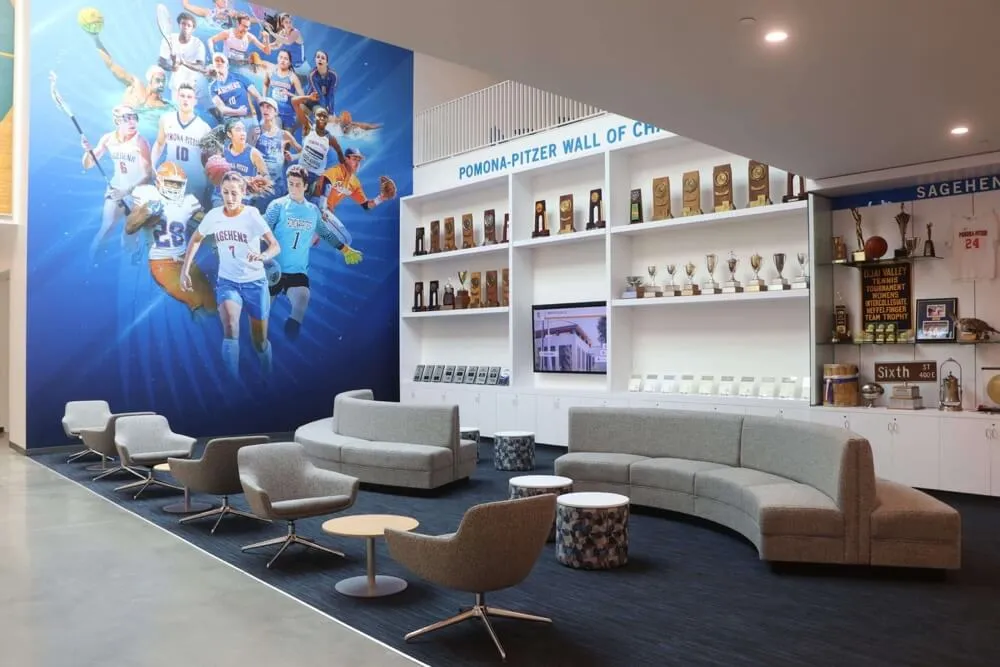
Over a 30-year period, this accumulation reaches 900-1,500 trophies. Even schools with multiple trophy cases can display only a fraction of this volume, forcing the rest into storage where they provide no ongoing recognition value whatsoever. The problem compounds over time—each passing year adds new awards while physical display capacity remains fixed.
Physical Trophy Case Limitations
Traditional trophy cases impose severe constraints on recognition programs. A typical six-foot trophy case holds approximately 40-60 trophies depending on size and arrangement. Multiple cases help but never solve the fundamental capacity problem—achievement accumulation outpaces display growth exponentially.
Space limitations force athletic directors into uncomfortable decisions about recognition priorities. Should the 1985 state championship remain displayed alongside the 2024 championship? Does the small cross country invitational trophy from last month deserve space that could showcase a major basketball championship from five years ago? These decisions reflect practical space constraints rather than actual achievement importance—a fundamentally unfair recognition system.
The consequences extend beyond administrative headaches. Athletes whose trophies sit in storage feel their accomplishments are undervalued. Alumni returning for reunions cannot find recognition of their achievements. Current students miss inspirational examples from program history that could motivate their own excellence pursuits.
The Hidden Trophy Problem
Walk through storage areas at most schools with 20+ year athletic programs and you’ll encounter familiar scenes: cardboard boxes filled with trophies, championship plaques leaning against walls, awards stacked on shelves alongside athletic equipment, and engraved plates that separated from deteriorating trophy bases decades ago. These aren’t valueless items—each represents student dedication, coaching excellence, competitive success, and moments of pride that defined school years for athletes and families.
Yet their value disappears once they leave public view. The inspirational power of recognition depends entirely on visibility. Trophies in storage inspire nobody, motivate no current athletes, and provide no ongoing return on the recognition investment schools made when purchasing them.
Understanding Trophy Digital Preservation
Trophy digital preservation creates comprehensive digital records that make physical awards permanently accessible regardless of storage location or physical condition. This process transforms three-dimensional objects into rich multimedia profiles that often provide more information and context than physical trophies ever could.
Core Components of Digital Trophy Preservation
High-Resolution Photography: Professional photography captures trophy details from multiple angles with consistent lighting and backgrounds. Images preserve current condition before further deterioration occurs, document engraving that may fade over time, show trophy size and construction in context, and create visual records suitable for both digital displays and printed materials if needed.
Quality matters significantly. Professional-grade photography with proper lighting ensures trophies appear attractive and legible in digital presentations. Poor photography undermines recognition value—blurry images or harsh shadows make digital preservation feel like an afterthought rather than genuine honor.
Comprehensive Data Documentation: Each digitized trophy includes complete achievement information such as award type and competition level (conference, sectional, state, national), recipient names and graduation years for accurate historical records, specific dates and event details providing temporal context, records set or milestones reached that made achievements special, and coaching staff during the achievement to credit program leadership.
This documentation creates searchable databases enabling instant discovery of specific awards or athletes. Students can search their names to find all trophies they helped earn. Alumni can locate achievements from their competitive years. Coaches can review program history systematically. These capabilities transform trophy collections from static displays into research resources serving multiple purposes.
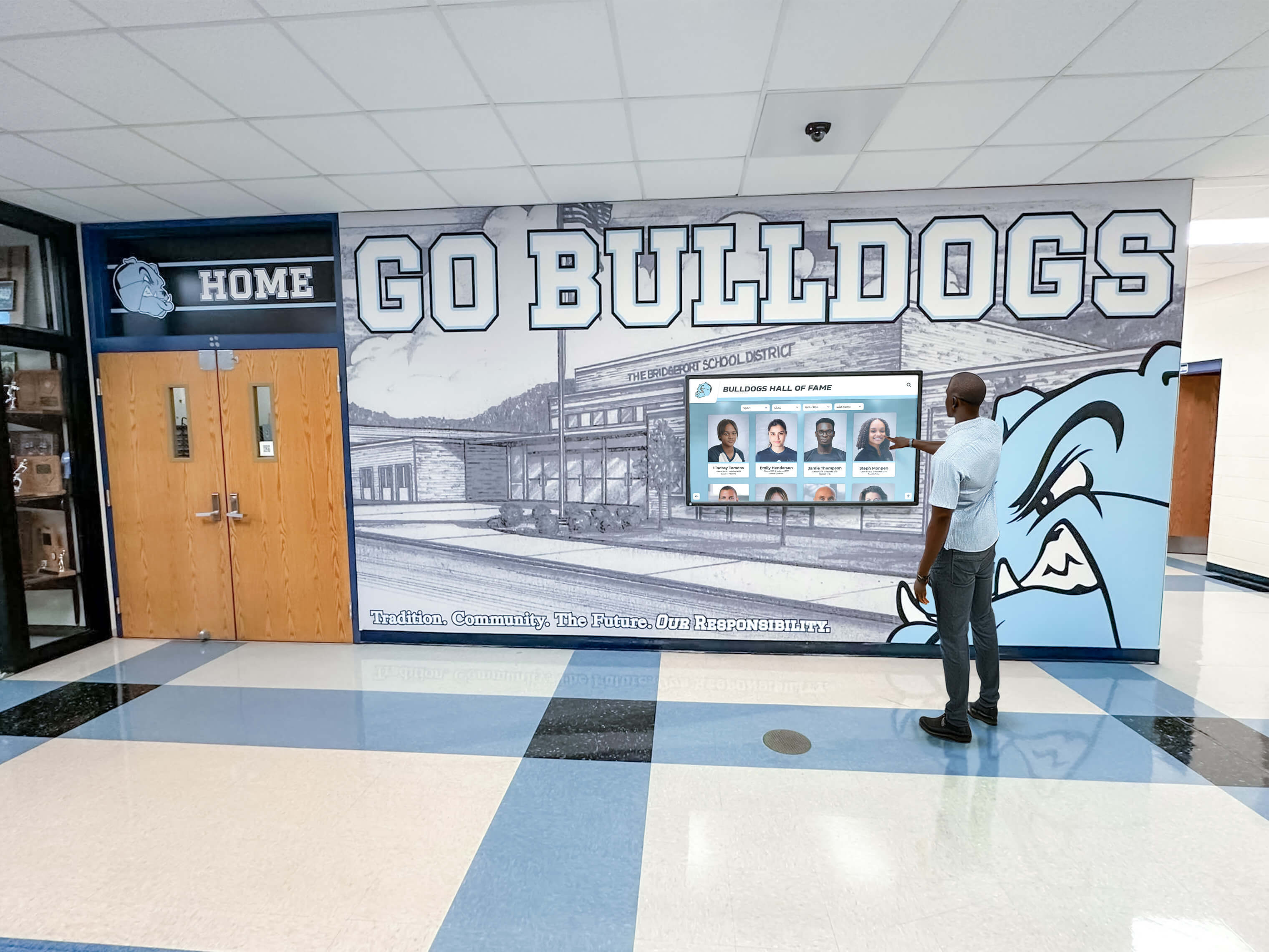
Contextual Enhancement: Digital systems enable adding context that physical trophies cannot convey including season records and tournament results placing awards in competitive context, newspaper clippings and contemporary coverage documenting significance, coach and athlete reflections sharing personal memories, facility and uniform historical documentation showing program evolution, and statistical comparisons demonstrating how achievements rank historically.
This enrichment transforms basic trophy catalogs into comprehensive storytelling. A simple championship trophy becomes a detailed profile: team photo, season record, tournament bracket, game highlights, individual statistics, coaching staff, and connections to other school records or championships. This depth creates meaningful engagement impossible with traditional displays.
Interactive Presentation Systems: Digital platforms make trophy collections accessible through multiple interfaces including touchscreen displays in athletic facilities for communal viewing, searchable web databases accessible from anywhere, mobile-responsive designs working on all devices, social media integration enabling easy sharing, and augmented reality features connecting physical spaces to digital content where appropriate.
These presentation systems ensure trophy preservation efforts serve maximum audiences. Physical preservation protects individual objects; digital preservation makes entire collections accessible to everyone, anywhere, anytime.
Strategic Benefits of Trophy Digital Preservation
Organizations implementing comprehensive trophy preservation programs discover numerous advantages extending well beyond simple space savings.
Unlimited Recognition Capacity
Digital systems eliminate capacity constraints entirely. A single touchscreen display or website can showcase thousands of trophies with complete documentation—content requiring dozens of traditional trophy cases to approach partially. This unlimited capacity fundamentally changes recognition strategy from “Which trophies deserve limited space?” to “How do we best organize and present our complete achievement history?”
Every trophy matters. Every championship deserves celebration. Every athlete receives appropriate recognition regardless of when achievements occurred or whether newer athletes have surpassed those marks. Historical significance remains visible and accessible, providing context for current programs while honoring those who built competitive foundations.
Schools implementing solutions like digital trophy displays report that recognition equity improves dramatically. Sports that previously received minimal acknowledgment due to smaller trophy sizes or less prominent programs now receive equal digital space. This equity communicates that all athletic excellence matters regardless of which program achieves it.
Enhanced Alumni Engagement and Connection
Digital trophy archives create powerful alumni engagement tools. Alumni visiting campus or browsing online can search their names to find every trophy featuring them, explore championships from their competitive years, see records they set and whether they still stand, watch video highlights when available, and share discoveries through social media integration with simple clicks.
This searchability creates personal connections that static displays cannot match. When alumni can find themselves within seconds and explore their complete athletic careers, emotional bonds strengthen. Many schools report alumni spending 5-10 minutes exploring digital displays compared to brief glances at traditional cases that may not even include their achievements anymore.
Enhanced engagement often translates to stronger institutional relationships. Alumni who feel their contributions remain recognized and valued demonstrate higher levels of ongoing involvement, event attendance, and financial support. The relatively modest investment in trophy preservation generates returns far exceeding the direct costs through these strengthened relationships.
Cost Reduction Through Digitization
While trophy preservation requires upfront investment, comprehensive cost analysis reveals substantial long-term savings. Digital systems eliminate recurring expenses for new trophy case purchases and expansion as collections grow, ongoing physical maintenance including glass cleaning and lock repairs, engraved plaque production for new achievements in traditional systems, physical trophy storage space that could serve other purposes, and labor costs for rearranging displays and installing new recognition.
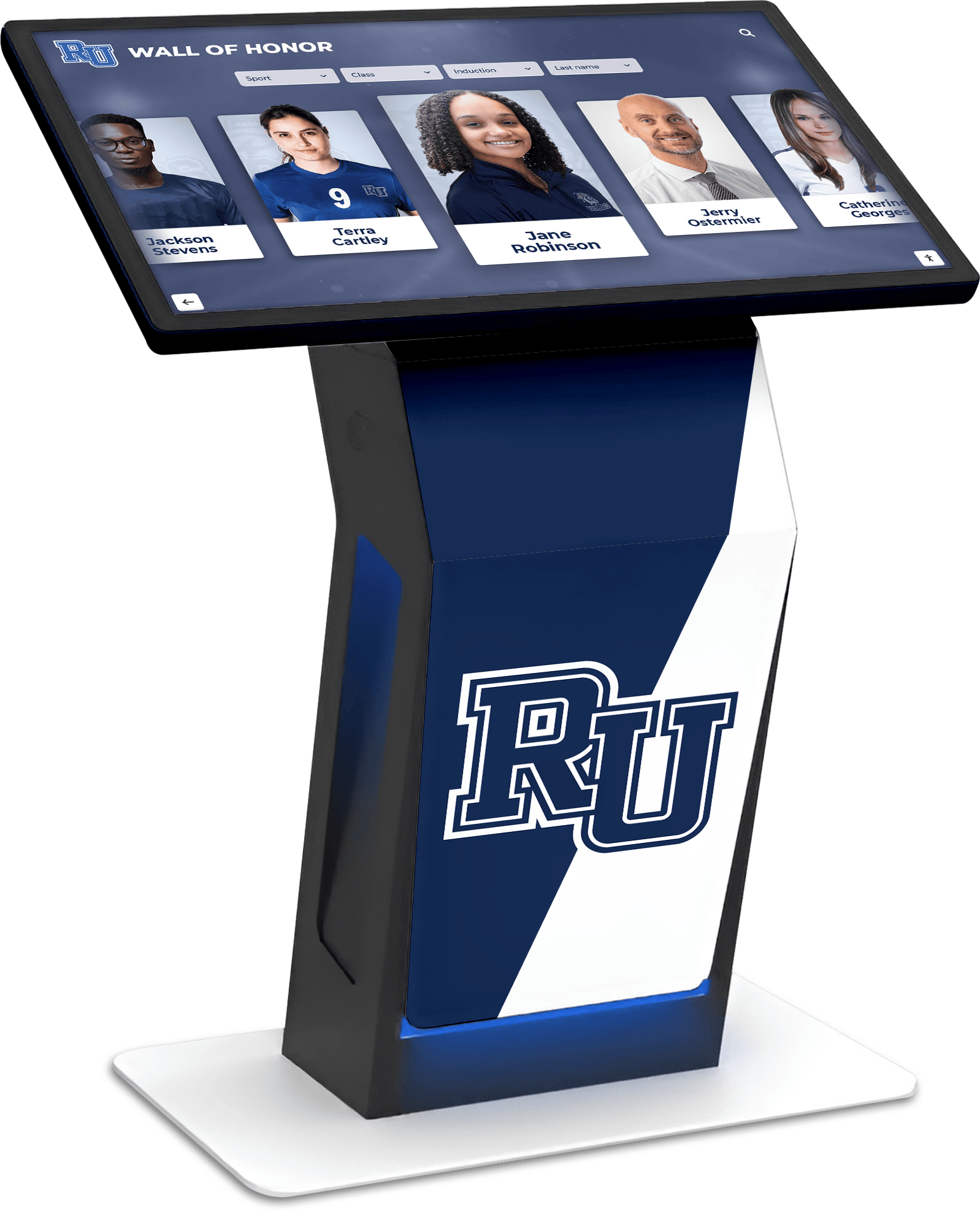
Consider a school currently maintaining three traditional trophy cases and adding 30 trophies annually. Over 10 years, they’ll need 2-3 additional cases ($6,000-$12,000), produce 300 engraved plaques ($6,000-$15,000), and invest 50-100 hours annually in physical updates ($5,000-$10,000 in staff time). Total 10-year traditional trophy costs: $17,000-$37,000.
Compare this to digital preservation: initial implementation ($8,000-$15,000), annual software subscriptions ($1,200-$2,400 for 10 years), and minimal maintenance ($1,000-$2,000). Total 10-year digital costs: $21,200-$41,000—comparable or lower than traditional approaches while providing exponentially greater capability and accessibility.
Preservation Against Physical Deterioration
Physical trophies face inevitable degradation. Metal tarnishes requiring polishing that many stored trophies never receive. Plastic components become brittle and crack with age. Engraving fades as finishes wear. Wood bases warp from humidity exposure. Trophy figures separate from bases as adhesives fail over decades.
Digital preservation captures current condition before further deterioration, creating permanent records independent of physical trophy fate. Even if physical trophies eventually must be discarded due to deterioration, storage costs, or facility changes, digital records ensure achievements remain permanently recognized and accessible. This protection proves particularly valuable for historical trophies from 30-50+ years ago that show significant deterioration but represent important institutional history.
Trophy Digitization Process: Step-by-Step Implementation
Successful trophy preservation follows systematic approaches ensuring comprehensive collections and consistent quality across all digitized items.
Phase 1: Comprehensive Trophy Inventory
Begin by cataloging everything that exists across your institution. Complete inventories require checking athletic director and coach offices where recent awards often reside, current trophy cases documenting displayed items, storage rooms and closets containing older trophies, equipment rooms where awards sometimes accumulate, maintenance areas where trophies may have been moved during cleaning or renovations, and administrative offices that may house special awards or historical items.
Document each trophy’s basic description and physical condition, engraving details noting recipient and achievement information, approximate date if not clearly engraved, current location for retrieval during photography, and condition issues that may require special handling or restoration before photography. This inventory provides baseline information for planning while often revealing forgotten trophies that disappeared from institutional memory years or decades ago.
Many schools discover 20-40% more trophies than expected during systematic inventories. Awards tucked in corners, trophies from discontinued programs, and long-forgotten championships emerge from comprehensive searches. These discoveries often include historically significant items that deserve prominent recognition once digitized.
Phase 2: Professional Trophy Photography
Quality photography requires specific techniques and equipment for optimal results. Lighting setup uses diffused lighting to eliminate harsh shadows and glare from reflective surfaces, consistent color temperature across all photos ensuring professional appearance, and adequate illumination revealing engraving details clearly even on tarnished trophies. Background selection employs neutral backgrounds preventing visual distraction from trophy details, consistent backdrops ensuring uniform appearance across collections, and proper backdrop size accommodating even large championship trophies.
Photography technique involves capturing multiple angles showing trophy from front, sides, and top perspectives, close-up shots documenting engraving legibility, full-context images showing trophy size and proportions, and detail photographs highlighting unique features or craftsmanship. Technical specifications require high resolution (minimum 12 megapixels, preferably higher) ensuring detail preservation, RAW format capture when possible allowing post-processing flexibility, proper exposure preventing highlight blowout or shadow blocking, and sharp focus throughout trophy ensuring all elements appear clear.
Many schools partner with professional photographers or leverage student photography programs to complete systematic documentation. Photography classes often welcome real-world projects, providing learning opportunities while completing institutional preservation work. Professional photography vendors specializing in product photography understand trophy-specific challenges and deliver consistent quality across large collections.
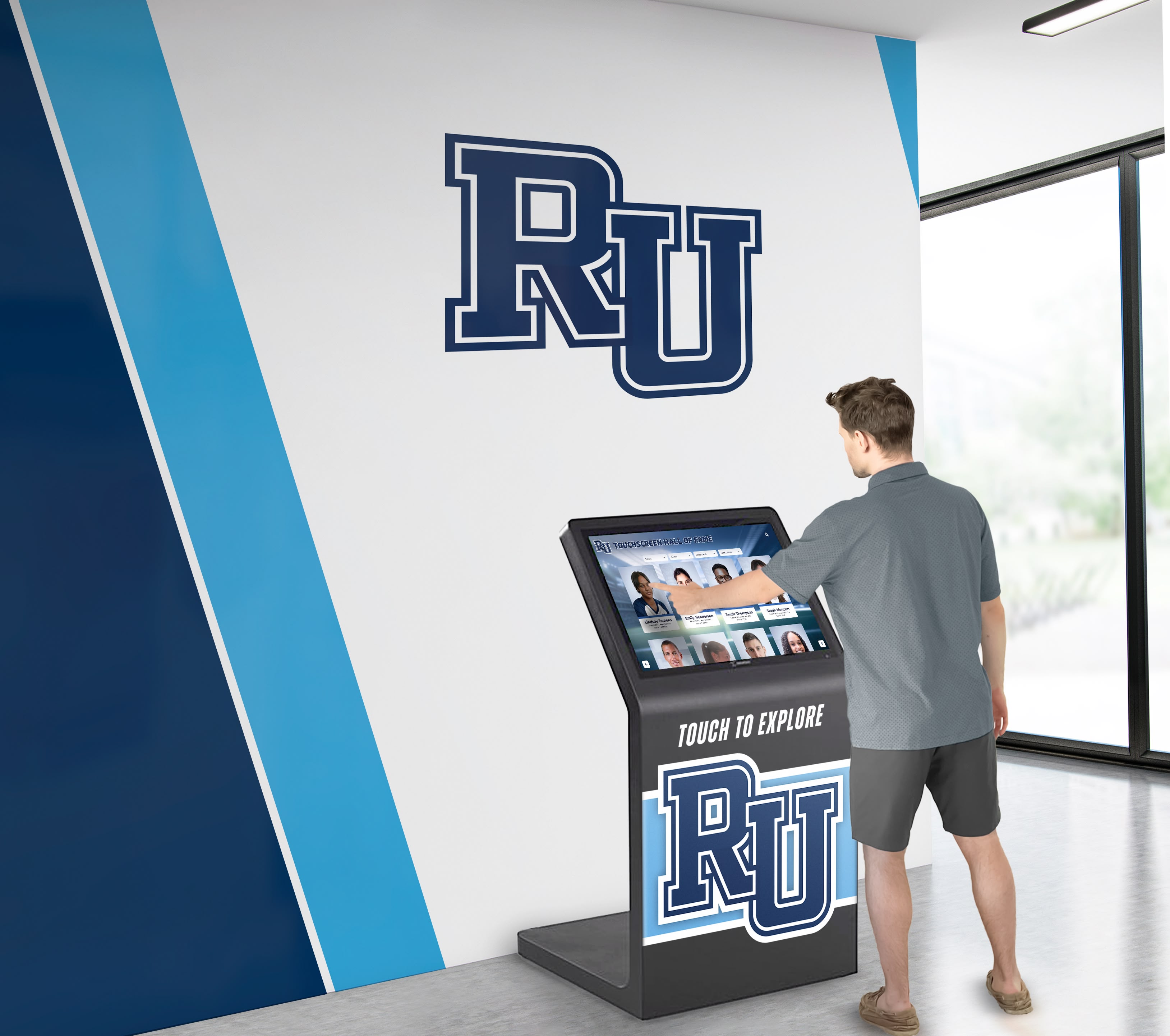
Phase 3: Detailed Information Documentation
Enter trophy data into digital platforms systematically. Required baseline information includes achievement title and type categorizing award clearly, recipient name and graduation year ensuring accurate attribution, competition date and level providing temporal and competitive context, sport and event details specifying exactly what was achieved, and coaching staff names crediting program leadership during achievements.
Enhanced contextual information adds substantial value when available including complete team rosters for team trophies, season records and statistics placing awards in performance context, tournament brackets or competition results showing path to victory, contemporary newspaper coverage or programs documenting significance, facility or uniform photos from achievement era showing program evolution, athlete biographical updates connecting to post-high school accomplishments, and connections to other related trophies or records creating comprehensive narratives.
This enhancement transforms basic trophy catalogs into rich historical archives. Current athletes gain context about program traditions. Alumni reconnect with specific memories. Community members understand institutional excellence depth and consistency. The time invested in comprehensive documentation pays dividends through increased engagement and appreciation.
Phase 4: Digital Platform Population and Organization
Upload completed photography and documentation to digital recognition platforms systematically. Organizational structure categorizes content by sport and gender creating intuitive navigation, chronological arrangement within sports showing program evolution, trophy type distinction separating team, individual, and special awards, and competitive level groupings highlighting conference, state, or national achievements.
Quality control processes verify photo quality and proper exposure before final publication, check accuracy of all entered information against source documents, ensure consistent formatting across similar trophy types, test search functionality confirming trophies appear in appropriate queries, and preview displays on multiple devices ensuring responsive design works correctly.
Platforms like digital recognition displays provide intuitive content management systems requiring no technical expertise. Athletic directors and administrative staff can manage content confidently, updating and enhancing trophy collections over time as new information emerges or new achievements occur.
Creating Engaging Digital Trophy Displays
Trophy preservation reaches its full potential when digitized content becomes accessible through engaging, interactive displays that transform passive viewing into active exploration.
Strategic Display Placement
Location significantly impacts engagement and recognition value. Primary installation sites include main athletic facility entrances capturing all visitors during events, gymnasium lobbies providing viewing time during games and practices, training facilities inspiring athletes during daily workouts, administrative areas for recruitment and alumni engagement, and outdoor-rated displays at stadium entrances for comprehensive visibility.
Multiple display strategies involve flagship installations in primary locations with comprehensive content, sport-specific displays in dedicated facilities showing relevant achievements only, rotating seasonal displays emphasizing currently active programs, and mobile displays for events, reunions, and special occasions extending recognition beyond fixed locations.
Schools with distributed campuses benefit from display networks where centralized content management updates multiple displays simultaneously. This efficiency ensures recognition stays consistent and current across all locations while minimizing administrative burden.
Interactive Features Maximizing Engagement
Digital trophy displays offer sophisticated interaction capabilities unavailable with traditional cases. Search and filtering enables users to find specific trophies by athlete name, year, sport, or trophy type instantly, browse chronologically through program history discovering evolution, filter by achievement level showing only championships or all awards, and locate related content connecting achievements to team photos or records.
Multimedia integration enriches trophy presentations with high-resolution photo galleries showing trophies from multiple angles, video highlights of championship performances or record-breaking moments, audio interviews with coaches or athletes reflecting on achievements, and historical documents like newspaper clippings providing contemporary context.
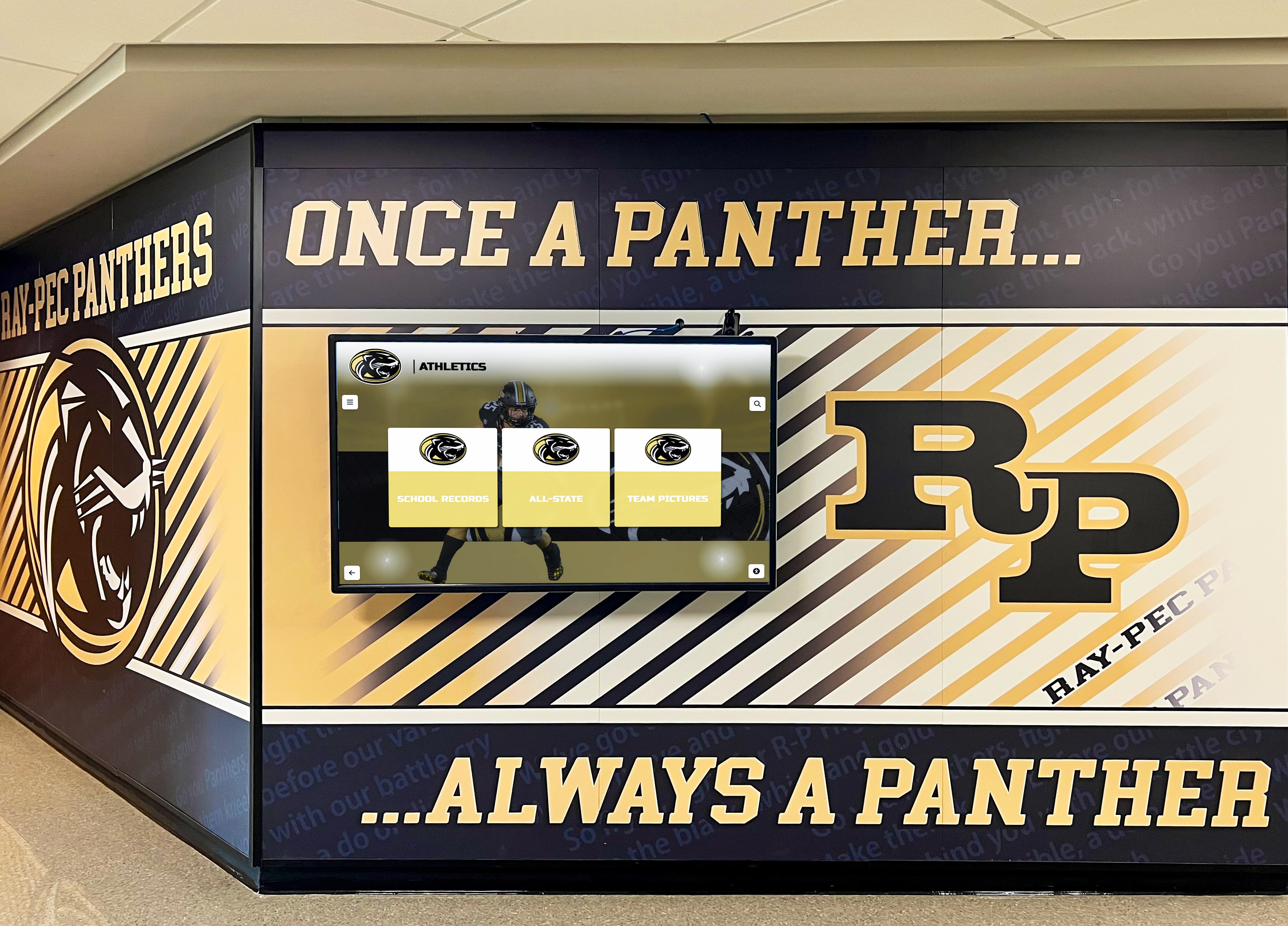
Social sharing features allow visitors to email trophy profiles to themselves for permanent records, share specific achievements on social media celebrating recognition, and download high-resolution images for personal use or media purposes where appropriate.
These interactive capabilities transform trophy displays from background decoration into engaging resources people actively explore. Schools report average interaction times of 3-5 minutes for digital displays compared to 15-30 seconds for traditional cases—dramatically increased engagement that multiplies recognition value.
Web-Based Access Extending Recognition Reach
While physical displays create high-impact communal experiences, web-based access extends trophy recognition to global audiences. Online trophy databases provide searchable access to complete collections from any internet-connected device, mobile-responsive designs working seamlessly on smartphones and tablets, secure access with appropriate authentication when privacy requires, and persistent links to specific trophies enabling easy sharing and referencing.
Alumni engagement applications use web access to allow graduates to explore their competitive years from anywhere, enable sharing of personal achievements with families and professional networks, and support reunion planning with historical context and nostalgia generation.
Recruiting and promotion leverages online trophy collections during virtual campus tours for distant prospects, in email campaigns to prospective families highlighting program excellence, and through social media showcasing recent achievements and historical tradition.
This multi-platform approach ensures trophy preservation investments serve maximum audiences and purposes, generating returns far exceeding the value of physical-only recognition systems.
Best Practices for Sustainable Trophy Preservation
Organizations with successful long-term preservation programs follow consistent practices ensuring quality results and ongoing value.
Establishing Quality Standards Early
Define clear standards before beginning large-scale preservation to ensure consistency. Photography standards specify minimum resolution requirements (typically 12+ megapixels), consistent lighting and background approaches across all images, required angles for different trophy types and sizes, file naming conventions enabling organized asset management, and quality review processes catching issues before publication.
Documentation standards establish required fields for all trophy entries ensuring completeness, formatting guidelines for dates, names, and achievement descriptions, verification processes confirming accuracy of entered information, and enhancement content priorities guiding which contextual details to pursue first.
Consistent quality across large collections ensures professional presentation that reflects positively on institutions. When multiple people contribute to preservation projects, clear standards maintain uniformity demonstrating attention to detail and respect for achievement history being documented.
Engaging Multiple Stakeholders in Content Development
Successful preservation projects involve diverse contributors bringing different knowledge and perspectives. Athletic directors provide overall coordination, priority setting, and administrative approval for preservation initiatives. Coaches contribute sport-specific knowledge about achievements, team rosters, and historical context that records may not capture. Alumni offer personal memories, achievement verification, and often possess photographs or documentation from their competitive years that schools lack.
Students provide technical assistance with photography and data entry, gaining valuable experience while contributing meaningfully to institutional projects. Administrative staff manage workflows, quality control, and ensure project timelines stay on track. Booster club members often enthusiastically support preservation efforts recognizing the value of comprehensive athletic recognition.
This collaborative approach builds broad ownership while improving content quality through diverse knowledge sources. People involved in preservation become advocates, promoting completed displays and encouraging community engagement with preserved trophy collections.
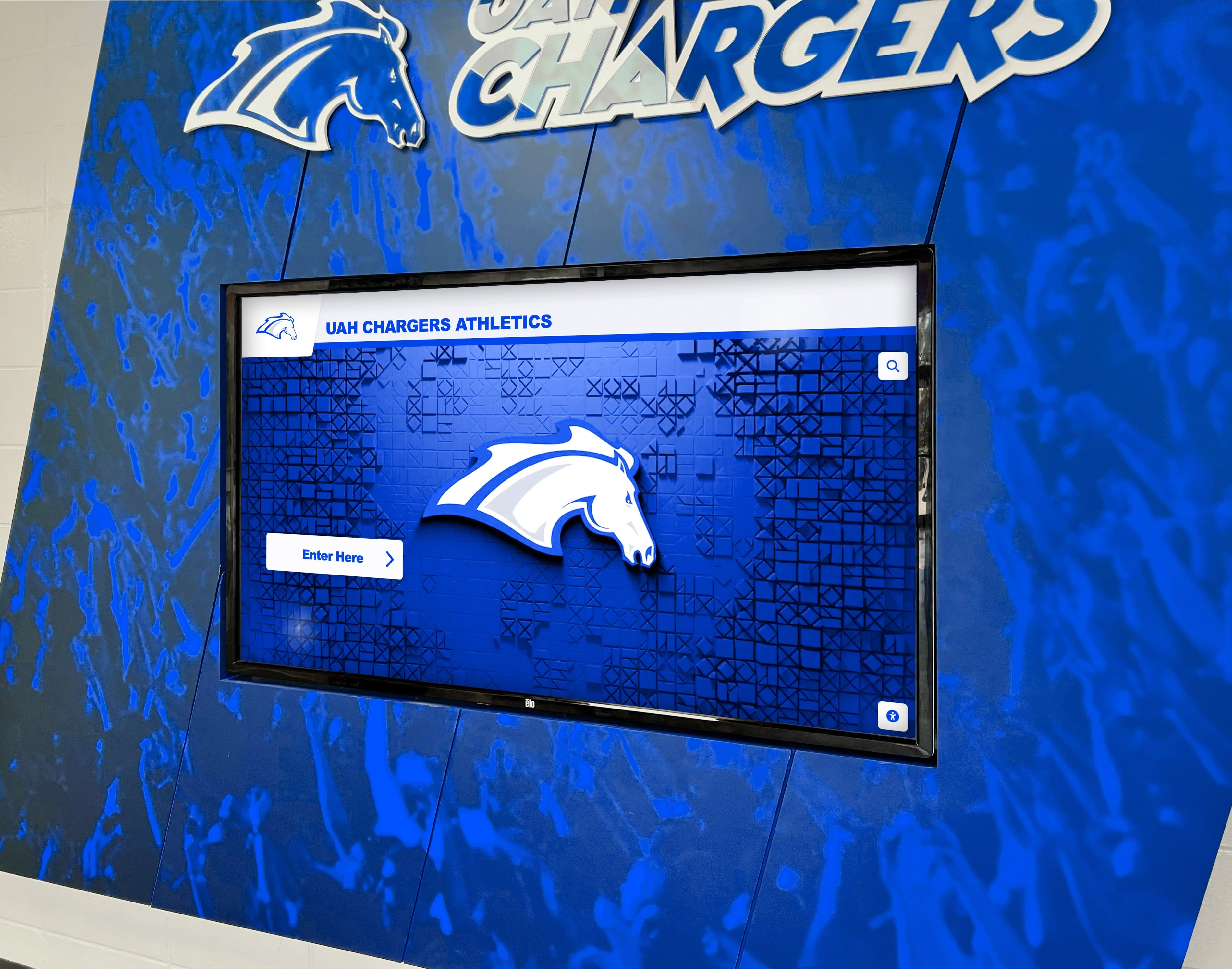
Planning for Continuous Enhancement
Digital trophy collections should evolve continuously rather than ending after initial preservation. Ongoing content addition immediately digitizes new trophies as they’re awarded maintaining collection currency, systematically adds historical trophies not included in initial phases, incorporates newly discovered items from storage searches or alumni contributions, and fills identified gaps where inventory revealed missing achievements.
Information enrichment seeks additional photos providing visual variety and historical context, solicits stories and reflections from coaches and athletes adding personal perspectives, researches newspaper archives and historical records deepening achievement documentation, and adds video highlights when footage becomes available or gets discovered.
Technical improvements take advantage of platform updates providing new features and capabilities, refreshes older content with improved photography when possible, optimizes organization based on user engagement analytics, and implements emerging technologies like augmented reality where appropriate.
This incremental enhancement approach delivers immediate value while working toward comprehensive collections that continuously improve over time. The investment keeps paying dividends as content richness increases engagement and recognition value.
Addressing Common Trophy Preservation Concerns
Organizations considering comprehensive preservation frequently raise similar questions deserving thoughtful responses.
“What Should We Do With Physical Trophies?”
Digital preservation doesn’t require discarding physical awards. Most organizations adopt hybrid approaches maintaining selective physical displays featuring showcase trophies for ceremonial and tactile value, properly archiving historically significant items ensuring long-term preservation, offering alumni opportunities to claim trophies from their competitive years creating positive engagement, and responsibly recycling standard participation trophies without unique historical significance.
The key principle: digital preservation enhances rather than replaces recognition by making all achievements visible rather than forcing choices about which fit limited physical space. Schools should preserve physical trophies they value while using digital systems to make comprehensive collections accessible to everyone.
“How Much Time Does Trophy Preservation Require?”
Timeline depends heavily on collection size and desired enhancement level. Basic preservation photographing 100 trophies with essential information typically requires 30-50 hours of work. Enhanced preservation adding historical research, multimedia, and rich context increases time investment by 50-100% but delivers correspondingly greater engagement value.
Phased approaches allow starting with priority content (recent championships and historically significant trophies) delivering immediate value while systematically adding remaining collection over subsequent months or years. This spreads workload sustainably while ensuring core content launches promptly.
Student involvement can substantially accelerate timelines when photography classes, journalism students, or athletic team managers contribute to content development under proper supervision. These contributions provide real-world learning while completing institutional preservation work.
“Will Digital Systems Become Obsolete?”
Modern cloud-based preservation platforms eliminate most technology obsolescence concerns. Unlike physical trophy cases requiring replacement as they fill or deteriorate, digital systems receive automatic software updates maintaining current functionality without school intervention. Content remains accessible regardless of underlying technology evolution.
Hardware like touchscreen displays typically operates 5-8 years before replacement—comparable to other institutional technology lifecycles and far shorter than the deterioration timelines of traditional trophy cases. Platform providers committed to long-term support ensure content remains accessible across hardware generations.
Select vendors with proven track records of long-term platform operation rather than startup companies with uncertain futures. Established providers demonstrate commitment to customer success and platform longevity that protects your preservation investment.
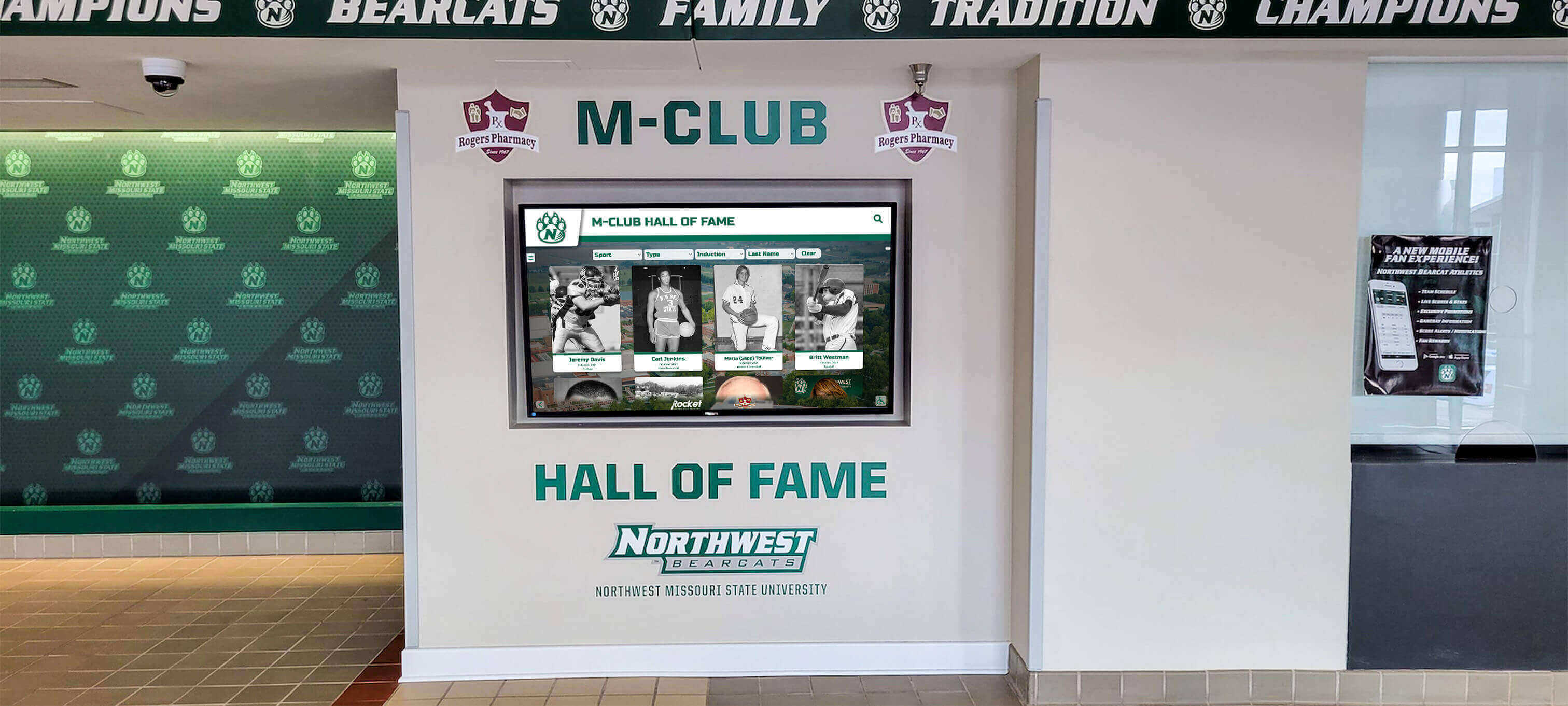
“How Do We Fund Trophy Preservation Projects?”
Preservation initiatives require funding but numerous sources provide options. Direct budget allocation from athletic or technology budgets treats preservation as capital improvement, booster club support often enthusiastically funds recognition enhancements, alumni association contributions recognize preservation as valuable alumni engagement investment, class reunion gifts from milestone classes (25th, 50th anniversaries) often focus on legacy recognition projects, and corporate sponsorships with on-screen recognition provide revenue while acknowledging business supporters.
Phased implementation spreads costs across multiple fiscal years making projects manageable within typical budget constraints. Hardware variation allows choosing display options fitting available budgets—starting with web-only access and adding physical displays when funding permits, or beginning with smaller displays and expanding to larger installations over time.
The key insight: trophy preservation generates tangible returns through enhanced engagement, improved recruiting, strengthened alumni connections, and eliminated ongoing traditional trophy costs. These benefits justify funding requests when presented as strategic investments rather than discretionary expenses.
Advanced Applications Extending Preservation Value
Organizations discovering trophy preservation flexibility find creative applications beyond basic achievement documentation.
Connecting Trophies to Comprehensive Athlete Profiles
Digital platforms excel at showing relationships between individual achievements and broader athletic careers. Multi-sport athlete profiles show all trophies earned across different programs demonstrating versatility, link to individual records held creating complete achievement pictures, display team photos from all sports showing breadth of participation, and connect to post-graduation updates tracking continued athletic or professional success.
These comprehensive profiles celebrate well-rounded athletes while encouraging multi-sport participation that research shows reduces injury risk and improves long-term athletic development. Seeing how successful athletes participated in multiple programs inspires current students to pursue varied athletic experiences.
Historical Trophy Evolution Displays
Organize digitized trophies chronologically to show how recognition evolved over decades. Trophy design evolution displays show changing styles reflecting different eras, document trophy sizes growing or shrinking over time, illustrate engraving and craftsmanship evolution, and connect trophy changes to broader cultural or athletic program shifts.
Achievement progression tracking demonstrates how program standards improved over decades as records fell, shows championship frequency changes reflecting program strength cycles, documents expansion into new sports or competition levels, and connects facility or coaching changes to achievement patterns.
These historical perspectives help current athletes appreciate program heritage while educating communities about institutional athletic traditions deserving celebration and preservation.
Coaching Legacy Comprehensive Documentation
Successful coaches build program legacies deserving thorough recognition. Digital systems enable detailed coaching documentation featuring all trophies won during specific coaching tenures creating legacy showcases, career statistics and win-loss records demonstrating sustained excellence, photos and videos across coaching careers showing program evolution, coaching philosophy statements articulating program values and approaches, and successor connections linking coaching generations maintaining program traditions.
This comprehensive coaching recognition honors those who built program foundations while helping current athletes understand values and traditions extending beyond any single season or team. For programs with long coaching tenures or distinguished histories, digital preservation ensures legacies endure beyond individual retirements and remain accessible permanently.
Implementation Roadmap for Schools and Organizations
Organizations ready to implement comprehensive trophy preservation benefit from systematic approaches ensuring successful deployment delivering intended value.
Month 1 - Assessment and Planning: Conduct comprehensive trophy inventory across all locations. Document current display limitations and storage situations. Form preservation planning committee including key stakeholders. Develop preliminary budget and timeline based on collection size. Research available platforms and providers considering needs and constraints.
Month 2 - Platform Selection: Request demonstrations and pricing from multiple vendors like Rocket Alumni Solutions. Check references from similar organizations about implementation experience and satisfaction. Evaluate features, ongoing support quality, and long-term vendor viability. Make platform selection and secure necessary funding through appropriate channels.
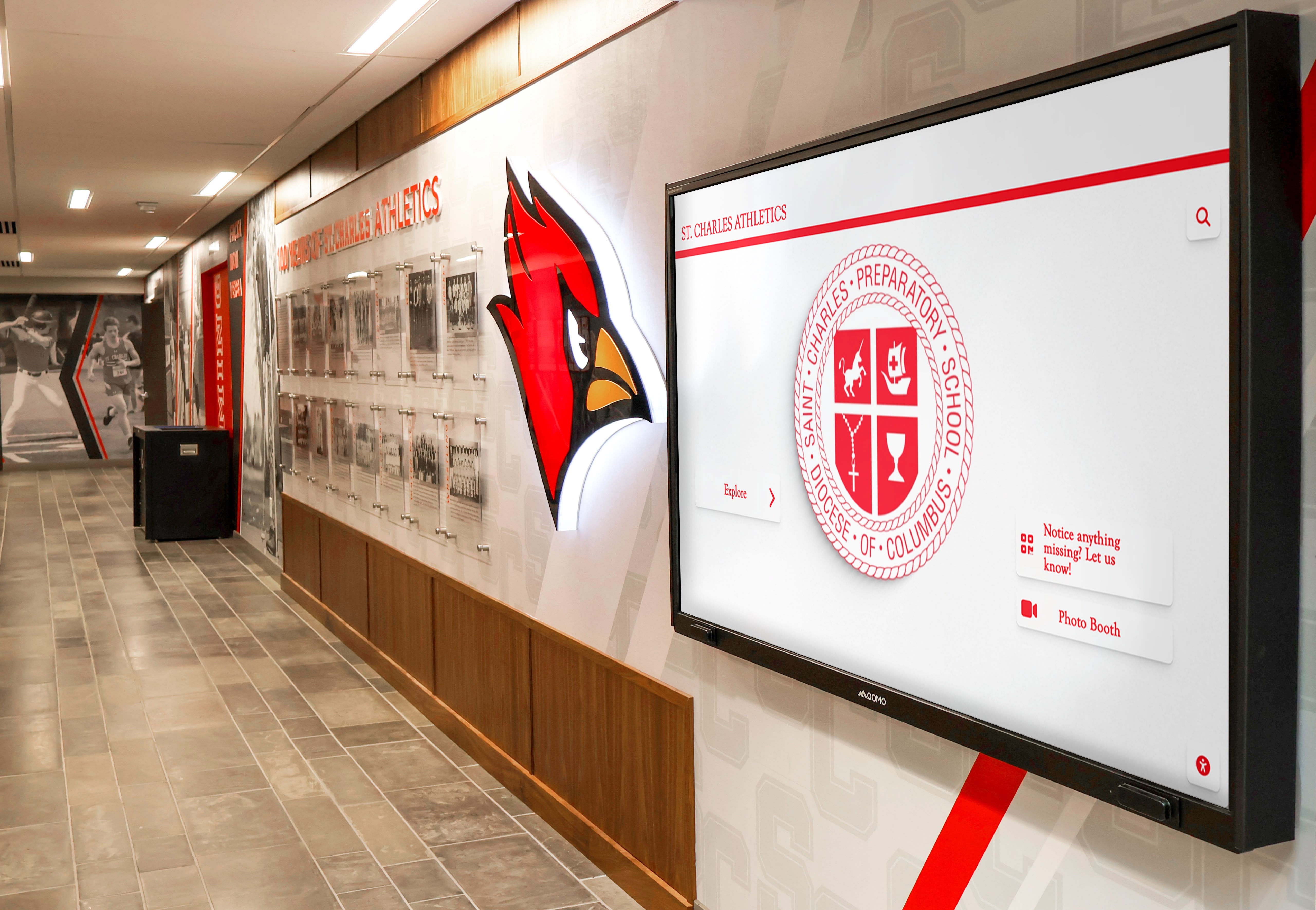
Month 2-5 - Content Development: Photograph trophy collections systematically using consistent approach ensuring quality. Enter achievement data and contextual information methodically. Gather enhancement content including team photos, statistics, and historical documents. Organize content using consistent structure matching platform organization. Conduct quality reviews ensuring accuracy and completeness before publication.
Month 5-6 - Platform Setup and Display Installation: Configure digital platform with institutional branding and organization. Complete site preparation including electrical and networking infrastructure if needed. Install display hardware and test functionality thoroughly. Load initial content and verify all features work correctly. Conduct staff training on content management and ongoing maintenance.
Month 6 - Launch and Promotion: Host grand opening event generating awareness and excitement throughout community. Promote through social media, newsletters, and communications. Demonstrate interactive features encouraging community exploration. Gather user feedback for potential refinements. Begin systematic historical content addition expanding coverage.
Month 6+ - Ongoing Management: Establish processes for immediate new trophy digitization maintaining currency. Continue systematic historical trophy addition expanding collection coverage. Monitor analytics understanding engagement patterns and popular content. Implement continuous improvements based on user feedback and platform updates. Plan expansion to additional displays or features as appropriate based on success and funding.
The Future of Trophy Recognition and Preservation
Trophy preservation represents more than solving current storage problems—it’s part of broader transformation in how organizations recognize, celebrate, and connect with athletic achievement in evolving cultural and technological contexts.
Emerging technologies promise enhanced capabilities including artificial intelligence enabling natural language search like “show me all state championships from the 1990s”, augmented reality features providing immersive experiences where visitors can virtually interact with trophy 3D models, blockchain authentication creating verified achievement credentials impossible to forge, voice interaction offering hands-free navigation improving accessibility for all users, and predictive analytics personalizing content based on visitor interests and interaction patterns.
Integration opportunities are expanding across platforms including athletic websites automatically pulling trophy content, social media feeds sharing highlighted achievements generating ongoing recognition, recruiting platforms showcasing program excellence to prospective athletes, and donor recognition systems connecting trophy achievements to fundraising campaigns.
Schools implementing comprehensive preservation now position themselves to adopt these enhancements as they mature, ensuring their recognition investments remain relevant and valuable for decades to come.
Honoring Every Athletic Achievement Through Digital Preservation
Athletic programs generate hundreds or thousands of trophies over decades—each representing student dedication, coaching excellence, competitive success, and memorable moments defining school identities. When space limitations force most trophies into storage, recognition value disappears despite significant achievement importance. Athletes whose accomplishments sit hidden receive no ongoing honor. Current students never see complete program excellence. Alumni feel undervalued when their achievements remain invisible.
Trophy digital preservation restores comprehensive recognition by making every award accessible, every championship visible, and every athlete’s contribution permanently acknowledged. This transformation moves beyond cluttered cases and overflowing storage to create organized, engaging showcases preserving institutional history while inspiring current athletes to add their own chapters to ongoing excellence stories.
Whether dealing with overflowing trophy cases, decades of storage accumulation, or simply seeking better ways to celebrate athletic success, digital preservation provides practical, engaging solutions. It honors past achievements comprehensively, celebrates present accomplishments immediately, and preserves excellence permanently through accessible, interactive recognition serving entire communities.
The transition from physical limitations to digital possibilities represents more than technology upgrade—it represents commitment to recognizing every athlete’s achievement, preserving every moment of excellence, and ensuring decades of dedication and success remain visible and valued for generations to come. In an era of increasing competition for student attention and community engagement, comprehensive recognition celebrating all excellence equitably becomes increasingly important for maintaining strong program culture and institutional pride.
Ready to preserve and showcase your complete athletic achievement history? Trophy preservation solutions like Rocket Alumni Solutions provide comprehensive platforms specifically designed for school and organization needs, combining professional digitization support, intuitive content management, engaging displays, and ongoing technical assistance ensuring long-term success. Every trophy deserves recognition—not just those fitting limited physical space. Digital preservation finally makes comprehensive celebration possible while protecting achievement history permanently.



































